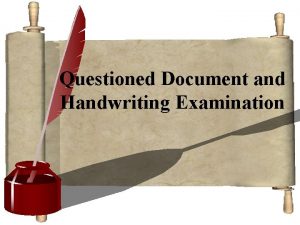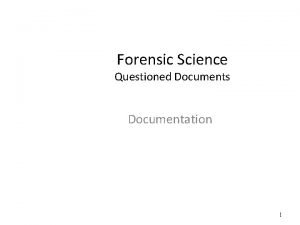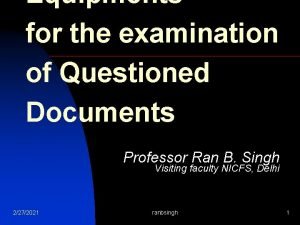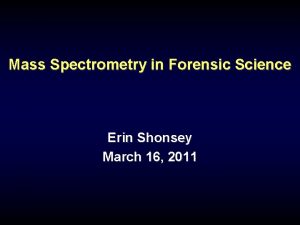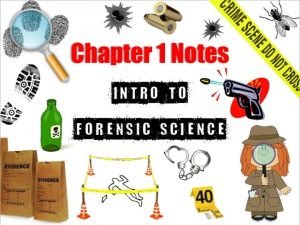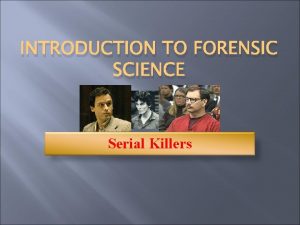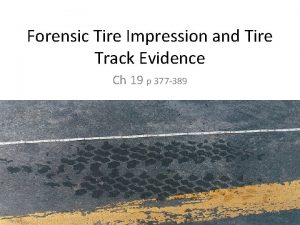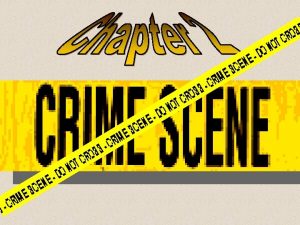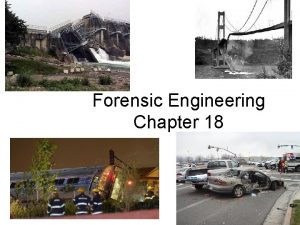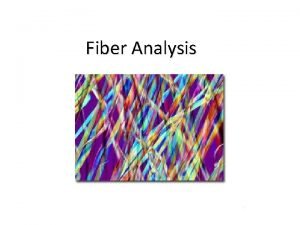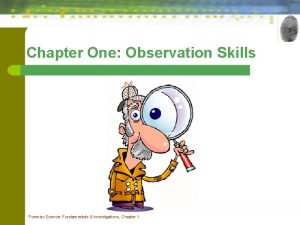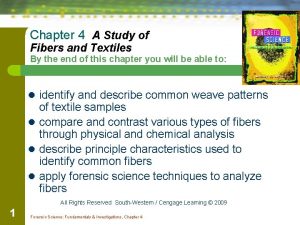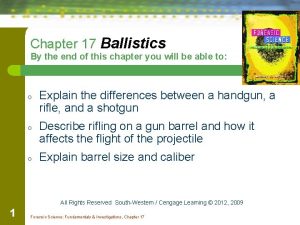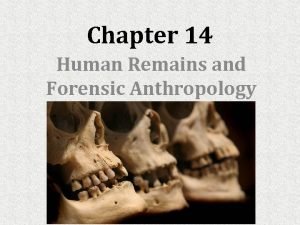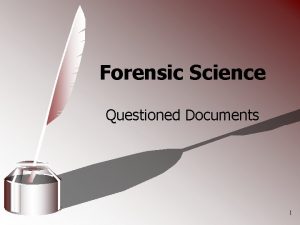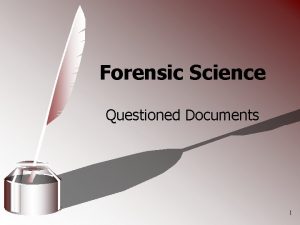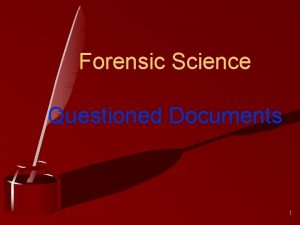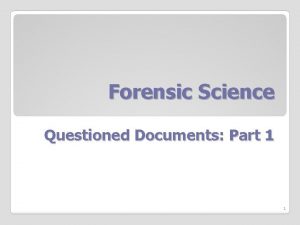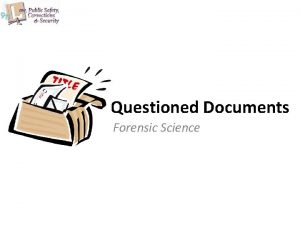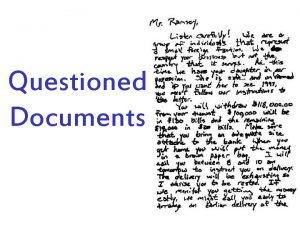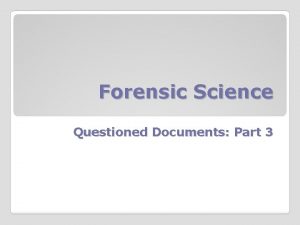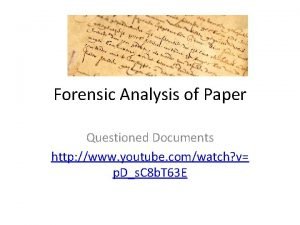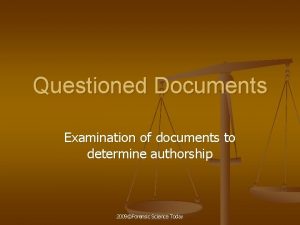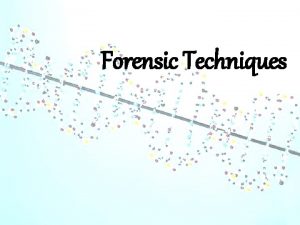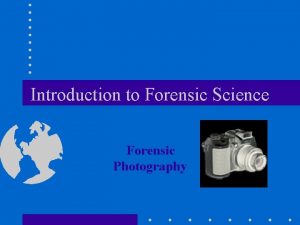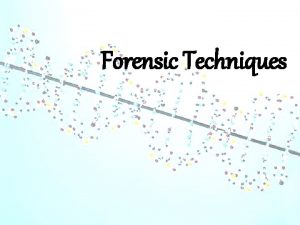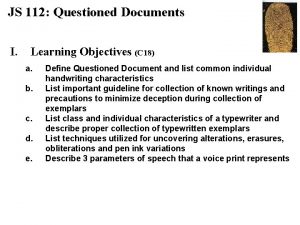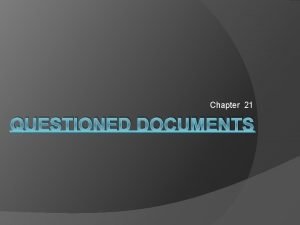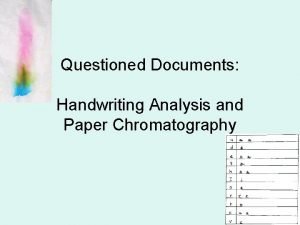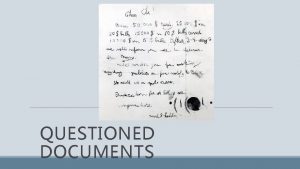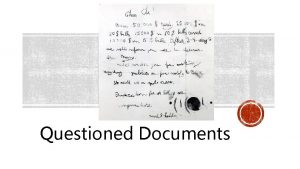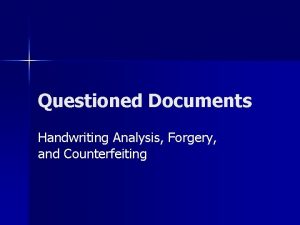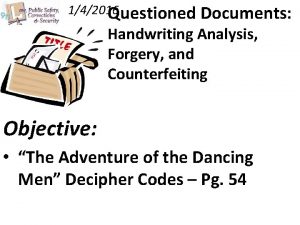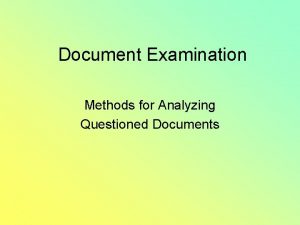Forensic Science Questioned Documents Part 2 1 In


























- Slides: 26

Forensic Science Questioned Documents: Part 2 1

In conjunction with hardware examination, a visual examination is performed. This visual examination will focus on specific handwriting characteristics. The Visual Examination 2

The Correct Expert �. Unfortunately, no federal licensing exists for a document examiner. However, certification is offered through the American Board of Forensic Document Examiners (ABFDE). �A certified document examiner is an acceptable witness in court. Compares questioned documents with known material in order to identify the source whenever possible �However, a graphologist attempts to predict character traits from handwriting examination. This type of “expert” is not acceptable as an expert witness. 3

Handwriting Analysis Handwriting Sample of President George Bush According to Sheila Lowe in her book, Handwriting of the Famous and Infamous, President Bush’s handwriting is “fast and highly simplified in fairly well-organized writing field”. Is this a forensic document examiner or a graphologist? ? 4

§ Occasionally a linguist will be asked to examine a document. These experts look at the linguistic content (the way something is written) of a questioned document. § The language that is used can help to establish the writer’s age, gender, ethnicity, level of education, professional training, and ideology. Forensics Linguistics 5

�For example, a kidnapper and murderer sent text messages from the victim’s cellular telephone to the family so the family would think she was still alive and texting them. �A linguist compared the “voice” of three months of text messages. The most recent texts (from the kidnapper) used the number 2 instead of to, ain’t instead of I’m not and fone instead of phone. �This comparison indicated that the victim did not send the most recent messages and was in fact dead. Forensics Linguists (cont) 6

§ § § Historical Dating—the verification of age and value of a document or object Fraud Investigation—focuses on the money trail and criminal intent Paper and Ink Specialists—date, type, source, and/or catalogue various types of paper, watermarks, ink, printing/copy/fax machines, computer cartridges Forgery Specialists—analyze altered, obliterated, changed, or doctored documents and photos Typewriting Analysts—determine origin, make, and models Computer Crime Investigators—investigate cybercrime Related Fields 7

After the Examinations are Complete Once the examination of the questioned document is complete, the investigator must decide if a crime has been committed. Possible crimes include: Fraud Forgery Counterfeiting Identity Theft 8

�Fraud is an intentional deception for personal gain or for harm to another. �Forgery is the process of creating, adapting or imitating objects or documents with an intent to deceive. �Therefore, forgery is a type of fraud. �The forging of money is counterfeiting. �The forging of a person is identity theft. Fraud, Forgery, Counterfeiting and Identity Theft 9

Documents Forged § Check Fraud § § Forgery § Counterfeit § Theft of card or number § § Alterations § Paper Money § Electromagnetic radiation § Chemical analysis Identity § Social Security § Driver’s license Art—imitation with intent to deceive § Microscopic examination § Counterfeit § Credit Cards § Contracts—alterations of contracts, medical records 10

Compare Two Checks 11

§ Simulated forgery—one made by copying a genuine signature § Traced forgery—one made by tracing a genuine signature § Blind forgery—made without a model of the signature Types of Forgery 12

Handwriting Comparisons § Although no two individuals write exactly alike, there may be resemblances is their general style. § The two most widely used methods taught in nearly all fifty states in the U. S. are the Palmer method (1880) and the Zaner-Blosser method (1895). 13

Palmer Method Zaner-Blosser Method 14

12 Handwriting Characteristics for Comparisons 1. Line quality: Are the lines smooth, free flowing, and rhythmic, or shaky, nervous, and wavering? 2. Spacing of words and letters: Examine the average amount of space between words and letter formation. 3. Ratio of relative height, width, and size of letters: What are the overall height, width, and size of the letters? 15

12 Handwriting Characteristics for Comparisons 4. Pen lifts and separations: Check if the writer stops to form new letters and begin words. Forgeries may have pen lifts in unusual places (e. g. in the writing of a single letter). 5. Connecting strokes: Compare how capital letters are connected to lowercase letters and how strokes connect between letters and words. 6. Beginning and ending strokes: Are the strokes straight, curled, long, or short? Are they made on the upstroke or downstroke? 16

7. Unusual letter formation: Look for unusual letter formations (e. g. letters with tails). 8. Shading or pen pressure: Check for pressure on the downward and upward strokes. 9. Slant: Does the writing slant to the left or right, or is it straight up and down? Are some letters consistently slanted more or less than others?

10. Baseline habits: Does the writing tend to follow a straight line, move downward, or move upward? Is it above or below the line? 11. Flourishes or embellishments: Are there any fancy letters? 12. Placement of diacritics: Check the crossing of t’s, dotting of i’s and j’s, or any other letters or punctuation marks.

�Margins, spacing, crowding, insertions, and alignment are personal habits. � Spelling, punctuation, phraseology, and grammar individualize each writer. Handwriting Comparisons 19

20

�The courts consider handwriting to be a personal characteristic (like eye color) therefore: ◦ Examples may be obtained before counsel is assigned. ◦ Are not a violation of the 4 th Amendment (search and seizure) ◦ The 5 th Amendment does not apply. Personal Rights 21

Handwriting Comparisons Circumstances may prevent a positive conclusion: § Insufficient number of known handwriting samples are available § Questioned writing may contain only a few words, deliberately written in disguise § Drugs and alcohol can alter writing habits 22

Collection of Handwriting Exemplars In gathering known writing samples for comparison, or exemplars: § Known writing should resembled the questioned document § Should contain some of the words and combinations of letters present § Give the range of natural variations § Should be fairly recent, usually within 2 -3 years 23

�Obliterations indicate that the document has been changed. An examiner must determine if the change is part of the original document. �An obliteration may be physical or chemical. ◦ An example of a physical obliteration is erasing with an eraser. ◦ A strong oxidizing agent can make ink colorless. This type of chemical obliteration is visible under UV lighting. Other Clues from the Visual Examination 24

Other Clues from the Visual Examination Indented impressions are often left on the paper that was underneath the original document. These indentions are due to the pressure of the writing utensil. Lighting at an oblique angle will enhance these indentations. 25

A CRAZY CRIMINAL’S SIGNATURE � According to Point of View, a magazine published by the Alameda county District Attorney’s office, a guy walked into an Oakland bank and handed the teller a note reading, “this is a stikkup. Hand over all yer money fast. ” � Guessing from this that the guy was no rocket scientist, the teller replied, “I’ll hand over the cash as long as you sign for it. It’s a bank policy that all robbers have to sign for their money. ” � The guy thought this over, then said “Uh, I guess that’s OK. ” He signed his full name and address. That’s where the cops found him a few hours later. 26
 Questioned documents include:
Questioned documents include: Questioned documents examples
Questioned documents examples Transmitted light examination in questioned document
Transmitted light examination in questioned document What is a questioned document
What is a questioned document Forensic anthropologist vs forensic pathologist
Forensic anthropologist vs forensic pathologist Who is this
Who is this Science modeling documents
Science modeling documents My favourite is science
My favourite is science Sola pith aptae viris
Sola pith aptae viris Hair forensic analysis
Hair forensic analysis Mass spectrometry in forensic science
Mass spectrometry in forensic science Who established the first workable crime laboratory
Who established the first workable crime laboratory Gil carrillo
Gil carrillo Forensic science history timeline
Forensic science history timeline Tyre impression forensic science
Tyre impression forensic science Forensic science serology
Forensic science serology Locard's exchange principle
Locard's exchange principle Forensic science foodborne outbreak investigation answers
Forensic science foodborne outbreak investigation answers What is forensic science definition
What is forensic science definition Forensic science begins
Forensic science begins Forensic science arson activity
Forensic science arson activity Forensic science chapter 18 review answers
Forensic science chapter 18 review answers Hair and fiber evidence worksheet answers
Hair and fiber evidence worksheet answers Why are observation skills important to forensic science
Why are observation skills important to forensic science Chapter 4 notes fiber evidence
Chapter 4 notes fiber evidence What is nibis
What is nibis Chapter 14 forensic anthropology
Chapter 14 forensic anthropology
